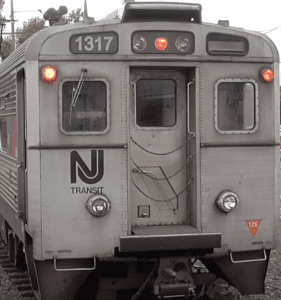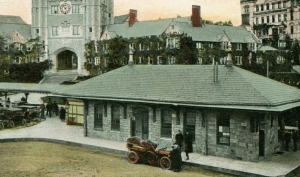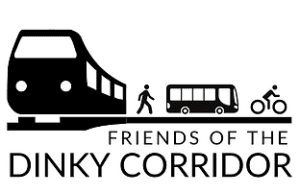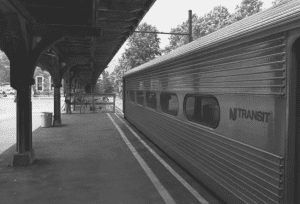 It was 3 am on a Sunday morning in June 1957. Local saboteurs cut the brake lines and removed blocks from the wheels of the train. Then it started to roll away.
It was 3 am on a Sunday morning in June 1957. Local saboteurs cut the brake lines and removed blocks from the wheels of the train. Then it started to roll away.
“Railroad police said the ‘dinky’ built up a terrific speed on the downgrade before Lake Carnegie and was still traveling at a good clip when it reached Princeton Junction,” according to the Town Topics that week. The Dinky continued as far as the old Walker-Gordon Dairy, now a residential development on Plainsboro Road, where it finally crashed into a line of freight cars.
For me there’s something romantic about the story of the runaway Dinky train, as if it were trying to expand its horizons. In fact, the Dinky has never quite gone that far again. The recent history of the Dinky has more to do with a narrowing of horizons.

It had once extended all the way to Blair Hall on Princeton’s campus, where students complained of soot from the coal-fired steam engines. In 1918, the Princeton terminus became the quaint, stone building that is today home to The Dinky Bar. In 2014, it was pushed even further from the town center with construction of the station it now shares with a Wawa convenience store.
Through it all, the Dinky has remained a point of pride for the community – our very own spur off the Northeast Corridor – and a great piece of transit trivia: at 2.7 miles, it’s the shortest commuter rail line in the country.
There’s more to the story than just distance. Everything surrounding the Dinky corridor has experienced change. Corporate parks and strip malls descended, and residential communities grew. Highways like Route 1 got bigger and wider. (More trivia: there used to be a small intermediate Dinky station that served the Penns Neck neighborhood of West Windsor, right on the southeast side of Route 1. The station was demolished in the 1970s.)
It’s hard, after all, to stop car culture. West Windsor expanded the parking lots around Princeton Junction a decade ago. And then, with the rise of Uber and Lyft, ridesharing became a one-click option for getting to the Junction. The result is that congestion remains an ever-present issue on the Route 1 corridor, not to mention the much larger and scarier issue of carbon-induced climate change.
The good news is that we’ve seen impressive investments in bike infrastructure along streets like Canal Pointe Boulevard, a flourishing of bicycle use since the pandemic, and now a move to e-transportation as well. The bad news is that infrastructure like the Dinky line has not kept pace. It’s not addressing regional needs. It’s not meeting enough of our ever-evolving, suburban mobility needs.
 But there is a vision for change. In November 2022, NJ TRANSIT released the findings of a concept-level review of the corridor. This followed months of engagement with community stakeholders and residents. There were four alternatives on the table and the agency opted for the most ambitious: turning the Dinky into a real “transitway” with dedicated bike and pedestrian lanes, along with a new light rail system on the existing line.
But there is a vision for change. In November 2022, NJ TRANSIT released the findings of a concept-level review of the corridor. This followed months of engagement with community stakeholders and residents. There were four alternatives on the table and the agency opted for the most ambitious: turning the Dinky into a real “transitway” with dedicated bike and pedestrian lanes, along with a new light rail system on the existing line.
(The bus and rail lines will share the right-of-way in the segment between the Junction and the Princeton station. A more costly option would have further widened the route in order to separate the two modes of transit.)
The study also called for a new “rubber-tired” bus route to make stops in the commercial business district and extend all the way to the Princeton Shopping Center on North Harrison Street.
The NJT proposal recognizes new mobility needs in our community and tries to meet them by adding more frequent service, more stops, and more connections between transit and local bike and walking routes. It will connect more people and more places, and do it more frequently.
 I believe it’s just the kind of change that we need. And I’m not the only one. A group of us started a local grassroots coalition called the Friends of the Dinky Corridor and pretty quickly gathered hundreds of petition signatures. Then came letters of support, from both town and gown, as well as positive coverage in the local press. The status quo, it’s become clear, is not working that well for residents, commuters, in-town workers, and students.
I believe it’s just the kind of change that we need. And I’m not the only one. A group of us started a local grassroots coalition called the Friends of the Dinky Corridor and pretty quickly gathered hundreds of petition signatures. Then came letters of support, from both town and gown, as well as positive coverage in the local press. The status quo, it’s become clear, is not working that well for residents, commuters, in-town workers, and students.
I have nothing against the old-school Dinky train. In fact, I really like it. I’ll often ride my bike to the Dinky and take it over to Princeton Junction, where I teach at the high school on Clarksville Road. This past year, when school buses were in short supply, I took my class on a field trip to Princeton and, of course, we traveled via the Dinky.
My son, Henry, loves trains and we used to go back and forth on the Dinky for no other reason than to enjoy the ride. He’d marvel at the tracks and the instruments and the conductor coming by to collect tickets. One of those rides sticks in my mind. It was a weekday evening, and we ran into a neighbor of ours commuting back into Princeton.
Henry, then just three-year-old and very curious, kept pointing at items all around him, including a flickering light just above. “What is that? What is that?!” he asked.
“That right there is aging American infrastructure,” said the neighbor, without skipping a beat.
Henry nodded solemnly, as if he had any idea what that meant.

But the remark was truer than I realized at the time. According to the November 2022 report, “NJ TRANSIT’s Arrow III fleet is 45 years old, and in need of retirement due to increasing maintenance costs and the difficulty in obtaining replacement parts.” This is not a question of wanting to replace the existing Dinky rail system but needing to. NJ TRANSIT won’t be able to operate the system, as is, in the years to come.
The price tag for a new, more expansive Dinky Transitway is sizable: $190 million. And this comes at a time of fiscal uncertainty for NJ TRANSIT. According to NJ Spotlight News, the agency’s “annual deficits could balloon near $1 billion” due to the impending loss of federal pandemic aid, and also to less ridership as more people do hybrid and at-home work.
I can appreciate how this might look like an argument for doing nothing at all. Because more cars and roads and sprawl represent less of an up-front investment for taxpayers. Instead, I think it makes a strong case for Dinky revitalization. The Princeton corridor is an opportunity to re-imagine public transit in suburban New Jersey, in a way that’s already happening in places like Montgomery and Prince George’s County, Maryland. Why focus our government expenditures on just getting corporate folks into and out of Manhattan on weekdays?
Consider that we need frequent and reliable service to get more consumers into Princeton. We need car-free alternatives for the people who work in local restaurants and retail establishments. (Unless you happen to relish the constant fights about parking policy in this town.)
And for me, as a father and teacher, here’s the one that matters most: let’s empower our kids on both sides of Route 1 to get around on their own. To school, the library, Halo Pub, the Arts Council, you name it. This is a country obsessed with the idea of freedom, and yet our suburban landscape offers little freedom of movement to those who are too young or too old to drive a car, or those who can’t afford one.
The point here is that transit advocacy is not some exercise in nostalgia. I realize we’re never going to reclaim, say, the two trolley lines that once connected Princeton and Trenton. But when there’s infrastructure in place right now, and a plan to make it more comprehensive and dynamic, then we need to act.
As far as I know, the police never found out who cut the brake lines back in 1957. But this time around, in the 2020s, we’ll know exactly who sabotaged the Dinky.
This is, after all, a vocal community – of parents and professors, store owners and students, bikers and walkers. And if we fail to show our support for a 21st-century Dinky transitway, then in the end we’re all to blame.
The easiest way to advocate is by signing the petition. But we encourage you to reach out to the offices of Governor Phil Murphy, Congresswoman Bonnie Watson Coleman, and our state-level representatives. And let’s urge the Princeton Mayor and Council to officially endorse the project.
Please make your voices heard. Should this train roll away, it won’t come back again.

Brian Levinson lives in the Jugtown neighborhood of Princeton with his family. He teaches high school World History in West Windsor. He previously worked in both city and state government in New York and also spent a year as a reporter in Mexico for an expatriate English-language newspaper.
